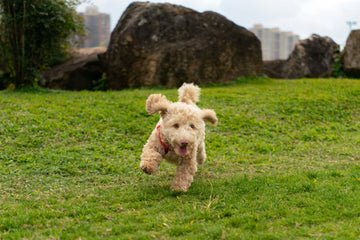You’re lounging on the couch when your dog hops up beside you. They stretch, sigh, and let out a long yawn — eyes squinting, tongue curling. It’s cute. It feels familiar. And most of us write it off as sleepiness. But what if it’s not that simple? The truth is, dog yawning is a subtle language — and your dog might be saying more than you think.

I. Why Do Dogs Yawn? (It’s Not Always About Being Sleepy)
Yes, dogs yawn when they’re tired. But dog yawning also happens when they’re excited, stressed, unsure, or trying to avoid conflict. Animal behaviorists have classified yawning as a calming signal — a way for dogs to regulate emotion and communicate non-verbally with others, whether they’re human or canine.
Dogs might yawn when they’re waiting for a walk, during a tense moment at the vet’s office, or when being hugged by a child. In these moments, yawning isn’t about fatigue — it’s a gentle way of saying, “This is a lot. I’m trying to cope.”
There’s also a social layer to dog yawning. Research shows that dogs often mirror their owners’ yawns — a behavior linked to emotional connection and empathy.

II. What If My Dog Yawns Too Much?
Here’s where awareness matters. While dog yawning is normal, excessive or repeated yawning can sometimes indicate discomfort, confusion, or underlying health concerns.
For example, if your dog yawns frequently during training, it may be overwhelmed or unsure of what’s being asked.
In that case, the best response is to slow down, simplify your commands, or take a short break.
If yawning occurs in calm settings — especially when paired with whining, panting, pacing, or restlessness — it may point to pain, nausea, or anxiety. That’s when a checkup with your vet is a smart move.

III. What Can You Do About Dog Yawning?
The key is to observe without trying to “correct” your dog’s yawns. Yawning is not bad behavior — it’s information. You can respond constructively in several ways:
-
Adjust the pace: If your dog yawns a lot during training, pause. Try again with easier steps and offer positive feedback.
-
Create a sense of safety: In new or overwhelming environments, give your dog space and comfort. Don’t push them to engage too quickly.
-
Offer stress outlets: Gentle walks, snuffle products, or chew toys can help dogs process emotional tension.

-
Track patterns: Notice when yawns happen and look for recurring triggers. It may reveal stress points or discomfort you hadn’t noticed.
-
Respect the signal: Above all, recognize that dog yawning is a way your dog communicates trust, confusion, or the need for calm. Listening is the first step in responding with empathy.
When you begin to treat yawns as a conversation rather than a quirk, your bond with your dog deepens — and so does your ability to care for them in a meaningful way.

IV. Frequently Asked Questions About Dog Yawning
Q: My dog yawns every time I grab the leash — what gives?
That’s excitement mixed with anticipation. Yawning helps regulate arousal before stimulating activities like walks or car rides.
Q: Can boredom cause yawning?
Yes. If your dog is under-stimulated mentally or physically, yawning may be a low-energy sign of frustration. Try adding enrichment to their routine.
Q: Why does my dog only yawn around certain people?
Dogs are sensitive to body language and energy. If someone makes them nervous — even without meaning to — yawning may be a calming mechanism.
Q: Should I correct my dog when it yawns too much?
No. Yawning is not a behavior to “fix.” It’s a natural, instinctive way for your dog to self-soothe or communicate.

So next time your pup lets out a long yawn, don’t just smile — listen. There might be more to that yawn than meets the eye.





